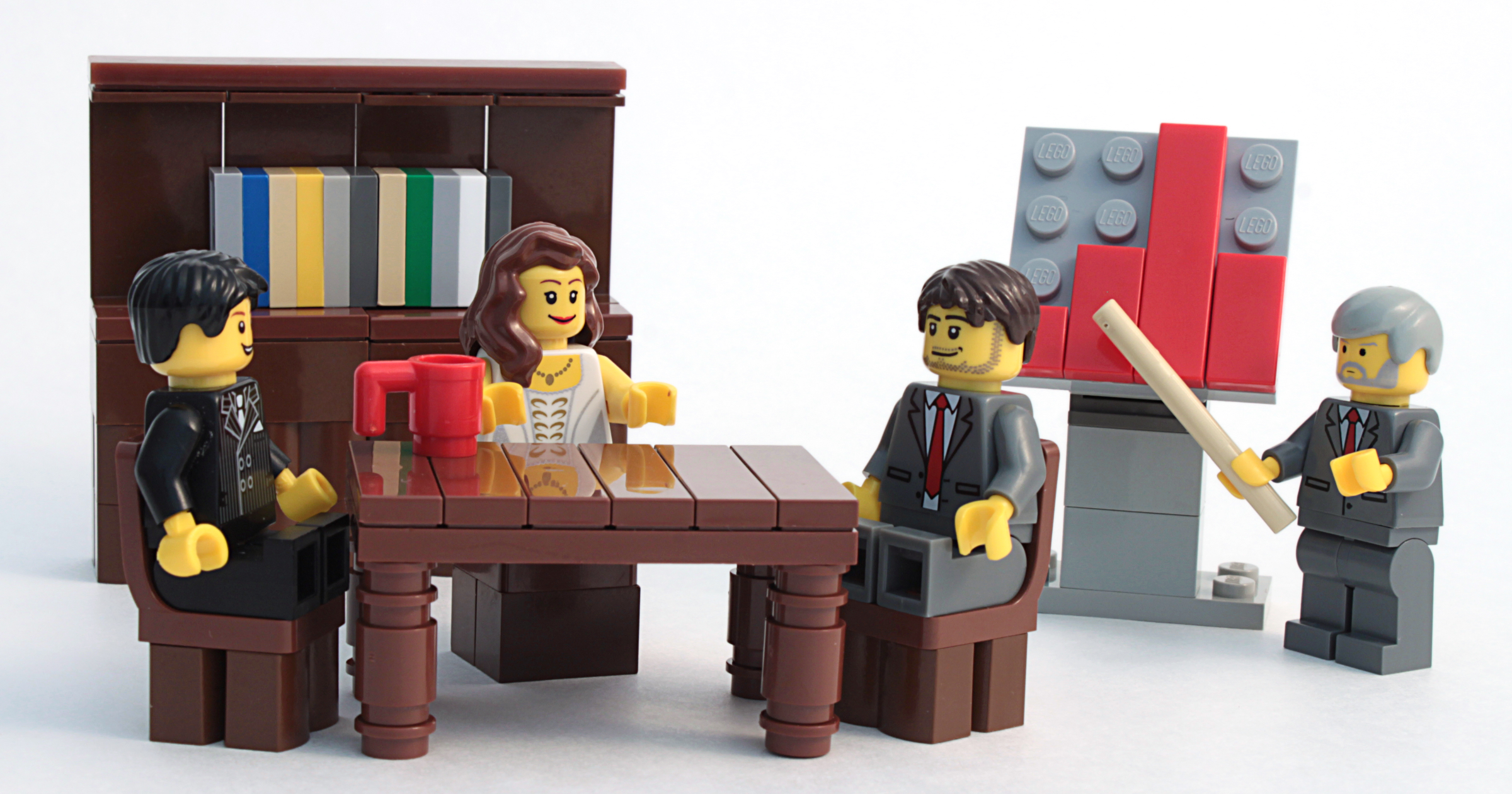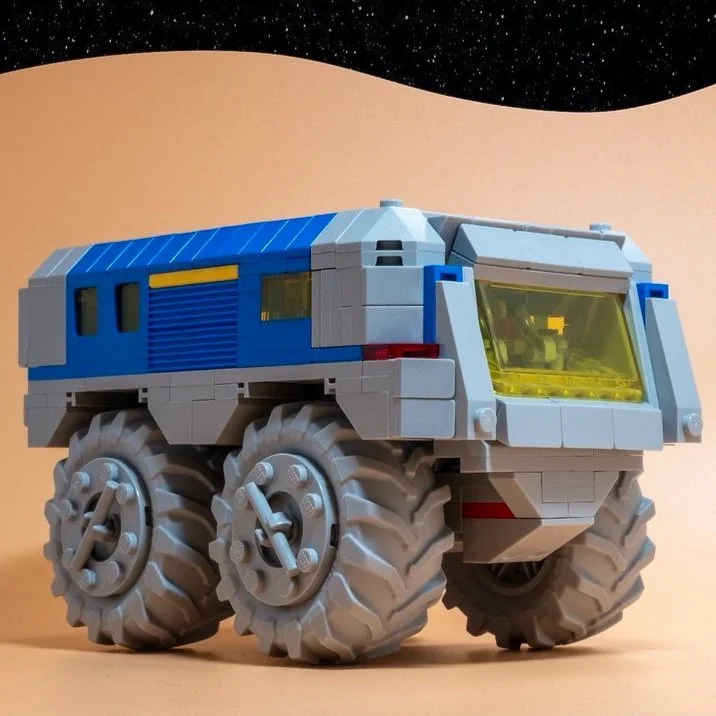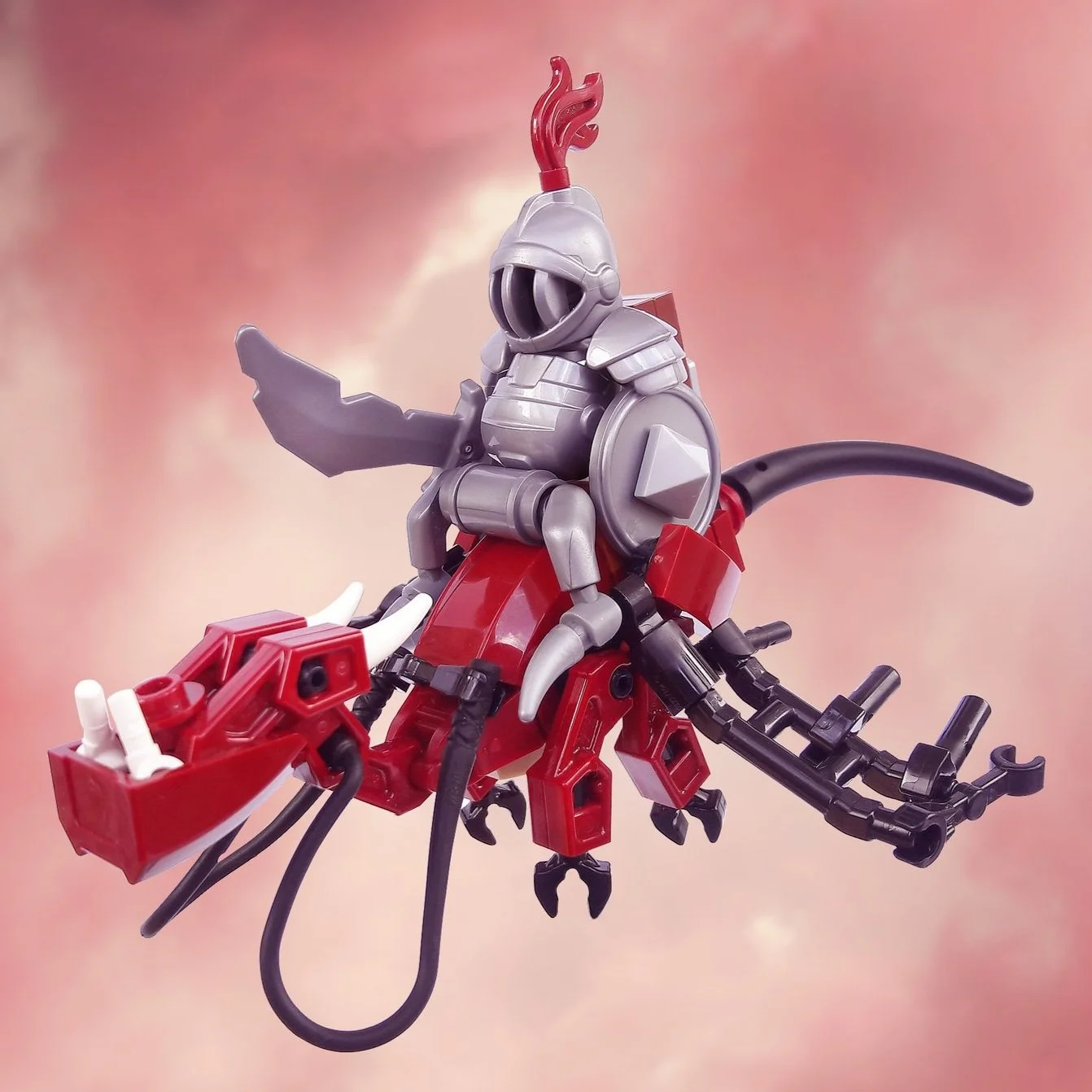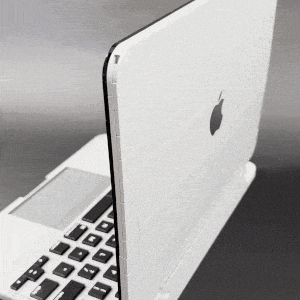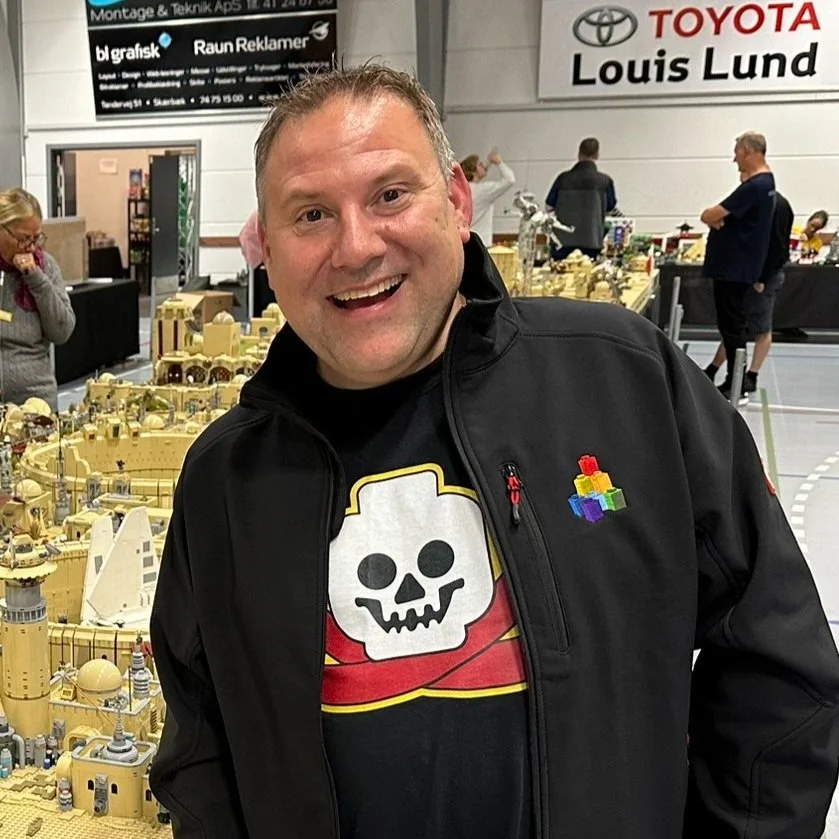LEGO at Work: Applying MOC-Building Lessons in the Workplace
/There was a time when outing yourself at work as having an extra nerdy hobby, such as building with LEGO as an adult, might not be perceived as a great way to enhance your career - unless, of course, you work at The LEGO Group. However, in the wake of COVID lockdowns and LEGO Masters television shows, the LEGO hobby has become more mainstream with adults than ever before. The LEGO Group has certainly responded to this with their “Adults Welcome” marketing campaign, and designing sets focused on the adult building experience. Thankfully with this greater mainstream acceptance comes a better understanding of what being an “Adult Fan of LEGO” is all about, making it much easier to explain the hobby to your fellow work colleagues.
All aboard the AFOL train!
My “real-life” job is on a data analytics team that supports the day-to-day operations of a mail-order pharmacy. Some years ago (well before COVID and LEGO Masters), our company asked everyone to participate in creating a diversity mosaic for our internal website. We would each submit a photo, along with three short “I am…” statements that we felt best defined ourselves or made us unique in some way. One of the statements I wrote for myself was that “I am… a LEGO Train Hobbyist.”
It had been ages since I built my last train, but since LEGO Trains are what brought me out of my LEGO dark age, I thought that statement might resonate with others still in theirs… Of course, had I also thought there was a chance it would be printed on a large banner and displayed in our company’s headquarters, I might have worded it differently 😅. In any event, I got a good laugh at discovering it written on a banner placed near the cafeteria... and I also got a lot of curious looks wondering what I thought was so funny.
image via Digital Learning
It was a few years after that banner sighting that I finally gave a presentation to my work colleagues about my LEGO hobby. As my team is primarily work-from-home, we are always looking for ways to foster better team cohesion in our virtual work environment. One of those ways was having each of us give a 25-minute “show-and-tell” presentation during our weekly team call on any topic of our choosing. At my manager’s insistence, I presented to the team on my LEGO MOC-building hobby.
I started with a short introduction about the LEGO hobby; building MOCs versus sets, digital building, the groups on social media, blogs and live-streams, attending conventions, acronyms, etc. I then presented the lessons I’ve learned through my years of MOC building, and how those lessons could be applied to our daily jobs. As some of you might also be interested in these lessons, I thought I would share them with you below… and what better way than through a PowerPoint presentation!
[“Click to the next slide please, Dave.”]
A LEGO Scene I created for a Different presentation on Drug supply issues.
Lessons Learned That Spark Creativity
Build A Story
For my “Great Steambug Migration” collaboration that I led at Brickworld 2017, it all started with a single Mr. Mectorian custom minifigure that I purchased from Crazy Bricks. I kept asking myself question after question, which helped to build the story, set the environment around him, and provide a rationale as to what should be built. If you ask nothing else about what you are building, the most important question to ask is “Why?”
Who is he? … Mr. Mectorian.
What is he doing? … Selling “Snake Oil to Steambugs”
How did he get there? … In his Victorian, steam-powered mobile home.
Who is he with? … A variety of different steambugs.
Where are they, and why are they all there? … They are migrating west across the southwestern desert.
Apply at Work - Ask the “5 Whys” to get to the true root cause of any problem.
Competitions Spark Creativity
As we always mention at the beginning of our monthly Contest Round-Up posts, “LEGO contests and challenges from all around the AFOL community can help you find some inspiration and motivation to build! There’s nothing quite like a theme or a prompt to take you out of your comfort zone and give you something new to try. Besides, contests are the perfect place to interact with other contestants and judges and get to know your fellow builders.”
The results of contests can also give you a good idea of personal progress and skill advancement… However, I felt it was important to clarify with my colleagues that these competitions I participated in weren’t just me as an adult bullying kids in LEGO contests intended for children (although children are certainly welcome to participate in them). There’s no honor in being the king of that dojo.
Applying at Work – Set a competitive challenge to overcome, but some words of caution. Competition amongst peers can also disincentivize the sharing of good ideas with one another. It is important to always remember that for the company to win, everyone needs to win.
Paired Passions Are Compelling
Examples of Builders who have paired their other passions with LEGO MOC Building
Some of the most amazing MOC builders in the community are the ones that have merged their other personal interests and passions with LEGO building. That can be a focus on microscale architecture, botany, sea vessels, space exploration, pop culture memes, you name it. Take this lesson to heart and literally build upon your foundational interests and strengths.
Applying at work - Build upon your strengths and knowledge from your other interests and areas of expertise. Celebrate what makes you unique.
‘Mash-Ups’ Are Compelling Too - Put A Twist On It
So let me set the stage; You immediately thought up the most awesome build idea for the latest contest. That’s awesome! Now I suggest that you immediately forget that idea and think up a new one. Odds are that was the most obvious idea to build, and at least half of the other entrants will have thought of it too. You can either stick with that idea and try to be the best at building it, or instead, you can kick it up a notch by adding a twist.
The added twist I like to use for my entries is trying to think up a “fusion” idea that takes the contest’s intended genre into a new and different direction. For the “Rock n’ Roll Steampunk” contest, I built a snow-covered floating island instead of the typical verdant grassy knoll (I also merged a steam train with a steamboat). For a speeder bike contest, I fused them into the Wild West setting of the “Lone Ranger”. I have found that contest judges tend to gravitate towards builds that have a good mix of both the familiar and new… which also makes this a calculated risk.
Applying at Work – Can our previous work be applied to entirely different areas?
Take A Calculated Risk
In the example above, the calculated risk I took was in an Aurebesh Starfighter Contest set in the Star Wars universe. The risk was only having the wings be shaped as the Onith letter that I chose as the inspiration, versus the entirety of the exterior perimeter being shaped that way. I thought that approach would be more realistic to the Star Wars universe, but the risk was that all of the voting judges might actually prefer starfighters that were shaped exactly like the letter. In the end, I find it best to stay true to your vision than to take what might be the easiest or most popular approach.
Applying at Work – Don’t limit yourself to only deliver what is requested or expected. Bring your own ideas.
Try It In A Different Color
As most LEGO MOC builders already know, LEGO does not mold all parts in all of their available colors. If you are looking to spark some creativity, if you simply try to build copies of the same design in different colors it will require you to make some part and design changes that you hadn’t considered.
Applying at Work – Try it out using a different tool, or on a different tech platform.
Diversity - Look For Unlikely Collaborators
For the “Race at Shadowlands” collaboration that I led at Brickworld 2018, I teamed up with fellow sci-fi builders with whom I had always wanted to collaborate. Once we honed in on the idea of having the speeder race set on a shadowy alien landscape, we knew we wanted to include some strange alien plant life. Rather than tasking that within ourselves, I reached out to Barbara Hoel to see if she would be interested in joining us, and incorporating her wonderful skills at LEGO botany. She had actually considered many of her plant sculptures as sci-fi creations anyway, so she was excited to join in the project.
Our collaboration with Barbara was indeed viewed as being unlikely by many Brickworld attendees. During public hours, one person came up to Barbara to let her know that some guys on the other side of the display hall had tried to copy her flower designs, but they weren’t nearly as good as Barbara’s 😂. Barbara replied with a “Thanks for letting me know,” and a knowing smile that she was the one who built them.
Applying at Work – Seek out diverse people from other functional areas for their unique contributions and perspectives. Participate in cross-functional initiatives at work.
“Renew / Reuse / Recycle”
This lesson is to use your prior builds as a jumping-off point for creating a different iteration or model entirely. Ask yourself, “How can it be reused and evolved into something even better?”
Applying at Work – Dust off your old analyses and refresh them. Build upon prior work. What was built before might be translated and applied to something else.
Create a Modular Building Platform
This lesson is very similar to the one above, but in this case you are being more proactive and intentional with it. In the example above, it all started with the basic “cockpit module” using Vahki brain stalk and Hero Factory panels. It is most easily seen in the photo of the Space Pod. From there, I created quite a few different vehicle types.
Applying at Work – Reach out to other potential users of what you are building, and develop solutions that can be used in multiple ways.
In A Lull? Start A Weekly Project
Another way to spark creativity is to start a weekly (or monthly) building project. A popular one is to build small vignettes or stackable minifigure habitats. This will be another example of having weeks with a lot of obvious ideas and others that will challenge you to dig a little deeper into your creativity.
Applying at Work – It’s kind of like starting a new habit. (Recommended reading: “The Power of Habit” - by Charles Duhigg)
Lessons Learned During The Building Process
Don’t Force It - Let The Parts Guide You
Mmmmmmm… That shaped up nicely.
In Oscar’s recent article about unleashing your creativity, he highlighted the importance of having a “fuzzy goal” of what the end model should look like. A great example of this was when I was building my M-wing starfighter for a Star Wars Alphabet Starfighter contest. My original concept was to build a “G-wing” shaped starfighter (a bit reminiscent of a cobra bent into that shape, with a curved tail ending at a central gun).
I wanted to use the large white tapered Technic panels for the starfighter. However, when I bent it into the shape of the “G”, the gaps between the panel sections just didn’t look good. As I was messing around with the panels trying to find a solution to this, I had an “Aha!” moment when I noticed a shape that looked like half of the letter “M”. The rest of the build took flight from there.
Applying at Work – Don’t let a preconceived notion of what the expected results should be dictate the analysis. Let the data guide you to the answer.
Don’t Arrive At One Cool Idea And Leave The Rest As Just “Good Enough” - Commit
The M-wing shape was such a great solution to my original problem that when it came to filling out the rest of the build, I admittedly did not give it my full attention. I was just filling up the remaining space. It took a pointed comment from Dan Rubin on a photo of the underside of the model to realize this.
After receiving his praise on the top-view of my build, this is what he had to say on the underside-view; “Ok, the underside is a little disappointing, but that's really just because of the quality of the top…” I could have just let the comment pass, but I wanted to know more. What was I missing? If I was going to accept his favorable opinion of the top, then I needed to equally accept his unfavorable opinion of the bottom.
That “M” shape of the M-Wing from above was my “one cool idea” and I had nailed it… but then Dan opened my eyes to the fact that I just ‘settled’ on many of my other part choices to finish the model. I thought the underside was ‘good enough’ in relation to the “M”, but upon self-reflection, it was anything but good. I’ve taken that lesson to heart, and try to consider every aspect of the build. However, sometimes I can still miss seeing something that I settled on, which leads to my next lesson.
Applying at Work – Follow your ideas throughout implementation. Commit to them, and pay attention to every detail.
Critiques Help You Improve
Getting an early critique from others on your WIP (work in progress) can be helpful to identify those areas of your MOC that you might be settling on as being “good enough”. You can send a trusted friend, or a builder you admire, a message with photos of your build asking them for suggestions. You can even expand this request for feedback into a live-build session in a chat room with a bunch of other builders. That is a quick way to bounce ideas off of each other and gain valued feedback.
In the case of my M-wing build above, I replied to Dan asking for his specific ideas on how to improve the underside of the build:
“I would either smooth out the bottom or greeble it up substantially more. Right now, it holds a middle ground that's a mix of boring and ugly (those anti-studs make a bad impression).”
He was blunt, but he was also correct. Based on that feedback I went back to “greeble it up substantially more” and vastly improved my design. It ended up being selected as the winner of that contest.
Applying at Work – Seek a critique, either 1-on-1 or during a project peer review.
Give It A Rest
Just a painting of squidman from the beloved Space Police sets.
Based on my experience with the M-Wing build, I have established a 24 Hour Rule for myself; Once I think a model is finished, I still wait at least 24 hours to see if any new ideas come up before calling it complete. I take a break and work on something else. If no further improvements come to mind, it is likely done and I can take the final photographs.
Applying at Work – Don’t rush to send out something early when you DO have time to spare. Sleep on it, take a walk, work on something else, and see if other ideas come forth.
Part Sorting Can Be Disheartening But Being Organized And Prepared Is Worth The Effort
Notice how I didn’t use a photograph of my own building table? (Thanks, Chris Maddison for posting a picture of yours being clean!)
I’ve already written my stance on part sorting and the merits of having a messy building table. That said, there certainly is value to sorting your part collection and workspace so that everything you need for your build is easily found. You will need to find your own balance in what amount of sorting and what amount of “table scrap inspiration” works for you.
Applying at Work – Take the time to get organized before you start working.
You Get Back What You Give
Here at BrickNerd, we have highlighted countless people who have helped build and strengthen our LEGO building community. The main lesson here is to be one of those people; Run online building contests. Host local meet-ups to promote MOC building. Donate builds for charity fundraisers. Give back to the community what it has given to you. Better yet, pay it forward.
Applying at Work – Look for opportunities to give back and “pay it forward”; Be a mentor, join an affinity group, or give award recognition.
Final Thoughts
I hope that some of these “Lessons from the LEGO Hobby” will be helpful to you in your future MOC building or workplace endeavors. If instead you fell asleep halfway through the presentation or got bored and decided to check your smartphone, I certainly understand. For you “tl;dr” folks (too long; didn’t read), here is a consolidated list of some of these key lessons that I hope can help you in both your MOC building and in your daily work lives.
Improvement happens quicker when you share your work and seek critique. Don’t do work in a vacuum.
Don’t be satisfied with a cool idea, and settle on the rest of the design. - DO sweat the details.
Sleep on it – take a break – walk away.
Diversity brings out our best work, and it goes deeper than the surface. Seek it out.
Collaborate with different people, and bring in their cross-functional expertise.
Tying different passions together can create compelling things.
Builds resonate more with people when they are things that they recognize, but they also want to see new things too. Strike a balance.
Try something new – set a challenge.
Practice makes perfect, so keep on building!
What tales do you have of bringing your LEGO hobby to work with you? Please tell us in the comments below.
Do you want to help BrickNerd continue publishing articles like this one? Become a top patron like Charlie Stephens, Marc & Liz Puleo, Paige Mueller, Rob Klingberg from Brickstuff, John & Joshua Hanlon from Beyond the Brick, Megan Lum, Andy Price, John A. and Lukas Kurth from StoneWars to show your support, get early access, exclusive swag and more.

